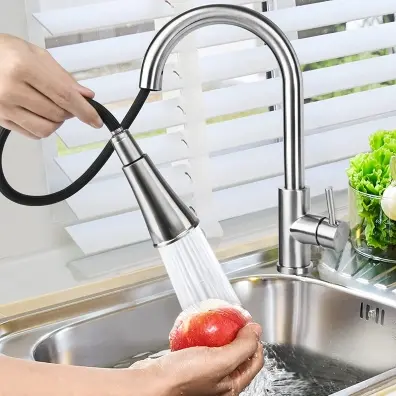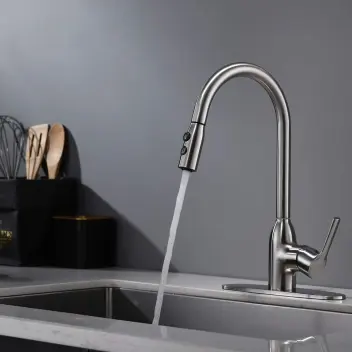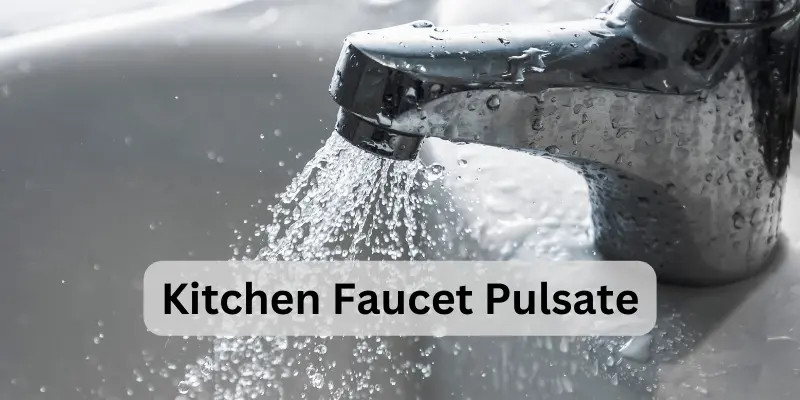A pulsating kitchen faucet causes frustration and irritation. When the water in the faucet pulsates, it converts smooth water flow into a turbulent stream. By knowing the causes of why a kitchen faucet pulsates, you can effectively solve the issue. A proper working kitchen faucet is essential to complete the daily kitchen chores.
With pulsating faucet, you won’t get proper water pressure and it affects the daily washing tasks. No one wants to deal with a pulsating kitchen faucet. So, keep reading the guide to know its cause and solutions.
Why Does My Kitchen Faucet Pulsate?

Water Pressure Fluctuations
For the proper functioning of a kitchen faucet, proper water flow is essential. When the water pressure is high, it causes excessive force on the faucet and becomes the reason for vibrations and pulsation in the faucet water. When the water pressure is low, it will cause uneven water distribution, and lead to pulsation.
If there is a malfunction in the system or the water main breaks, it will increase water pressure. These abrupt changes can create a surge of water through the faucet, leading to pulsation.
Air in the Water Lines
If there is air in the water lines, water in the kitchen faucet will pulsate. The main reason for the air into the water is routine maintenance or repairs of the water supply lines. When the air is trapped in the water, it travels into the water supply lines and reaches the faucet.
This air in the faucet disturbs the water flow and pulsates it. It will create an uneven flow of water and create an inconsistent stream of water.
Air in the water lines can also affect the functionality of other components within the faucet. For instance, if air becomes trapped within the faucet’s valves or cartridges, it can hinder their smooth operation. This can lead to further disruptions in water flow, exacerbating the pulsation issue.
Clogged or Dirty Aerators
The aerator in the faucet is used to make the water flow smoothly. It conserves water by reducing the flow of water while maintaining a consistent stream of water.
But with time, due to mineral buildup, the aerator becomes clogged and dirty. A clogged aerator is a common issue in most houses. These accumulated particles restrict the flow of water, causing an uneven distribution and resulting in pulsation. Due to clogging, the aerator can’t mix air into the water and cause uneven water flow.
Faulty Valves or Cartridges
Valves and cartridges are integral components within a faucet that controls the flow and temperature of the water. Valves regulate the on/off function of the faucet, allowing or blocking the water flow. Cartridges, on the other hand, control the mixing of hot and cold water to achieve the desired temperature.
If the valves or cartridges within the faucet become worn out, damaged, or misaligned, they may not operate properly. This can result in irregular water flow, pressure fluctuations, or even complete blockages. When the water flow is disrupted by these faulty components, the faucet may pulsate as the water tries to navigate through the restricted passages or encounters obstacles within the valve or cartridge.
Water Hammer
A water hammer, also known as hydraulic shock, occurs when the flow of water is suddenly stopped or redirected. It is caused by the rapid change in water velocity, resulting in pressure surges within the plumbing system.
Water hammer can occur due to various reasons, including quick closing of valves, abrupt changes in water direction, or inadequate air chambers in the plumbing system.
When a water hammer event occurs, the shockwaves generated travel through the pipes and can reach the faucet. These shockwaves create a sudden surge of pressure that can cause the faucet to pulsate.
The pulsations occur as the pressure fluctuates rapidly due to the shockwaves traveling back and forth within the plumbing system.
The impact of water hammer on faucet performance can be significant. The sudden increase in pressure can strain the faucet’s internal components, such as valves and cartridges, leading to damage or wear over time. As a result, the disrupted flow caused by these faulty components can contribute to pulsation when the water flow is affected by the water hammer effect.
Water hammer can be caused by various factors, including abrupt valve closures, water line obstructions, or inadequate air chambers within the plumbing system. It is important to address water hammer issues promptly as they not only lead to pulsating faucets but can also cause damage to the entire plumbing system if left unresolved.
Read also – Why Spray Function Diverter Is Not Working In The Kitchen Faucet?
How To Fix a Pulsating Faucet?

Adjusting Water Pressure
- Locate the water pressure regulator, usually installed near the main water supply valve or inside the pressure-reducing valve.
- Use a screwdriver to adjust the regulator’s setting, following the manufacturer’s instructions.
- Test the faucet after each adjustment to find the optimal pressure that eliminates pulsation.
Bleeding Air From The Lines
- Open all faucets in your home, starting from the lowest point, until the water flows smoothly without any air bubbles.
- Close the faucets and check if the pulsation problem is resolved.
Cleaning or Replacing Aerators
- Remove the aerator from the faucet spout.
- Soak the aerator in vinegar or a descaling solution for about 30 minutes to dissolve any mineral deposits.
- Scrub the aerator with a toothbrush to remove any remaining debris.
- Rinse the aerator thoroughly and reinstall it back onto the faucet spout. Test the faucet to see if the pulsation has been eliminated. If the problem persists, consider replacing the aerator with a new one that matches your faucet model.
Repairing or Replacing Faulty Valves or Cartridges
- Turn off the water supply to the faucet.
- Remove the handle of the faucet to access the valve or cartridge.
- Inspect the valve or cartridge for any signs of damage, such as cracks or wear.
- Depending on the specific issue, you may need to repair the existing valve/cartridge or replace it entirely.
- Consult the manufacturer’s instructions or seek professional assistance for guidance on repairing or replacing these components.
Installing Water Hammer Arrestors
- Water hammer, which can cause pulsation, is the result of hydraulic shockwaves in the water lines.
- Install water hammer arrestors, which are devices designed to absorb the shockwaves and prevent pulsation.
- Locate the main water supply valve and turn it off.
- Identify the water hammer arrestor placement points, usually near the valves or fixtures where the pulsation occurs.
- Follow the manufacturer’s instructions to install the water hammer arrestors, ensuring proper alignment and tight connections.
- Once installed, turn the water supply back on and check if the pulsation has been resolved.

James Lewis is a seasoned plumber and faucet enthusiast who shares his expertise on Faucetsavvy.com. With over 15 years of experience in the plumbing industry, he’s passionate about helping homeowners find the perfect faucet for their needs. He’s also dedicated to empowering DIY enthusiasts with the plumbing knowledge and skills needed to repair and maintain their faucets.

